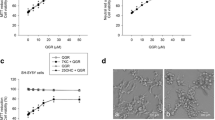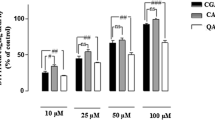Abstract
The present study assessed the influence of intracellular Ca2+ and calmodulin against the neurotoxicity of oxysterol 7-ketocholesterol in relation to the mitochondria-mediated cell death process and oxidative stress in PC12 cells. Calmodulin antagonists calmidazolium and W-7 prevented the 7-ketocholesterol-induced mitochondrial damage, leading to caspase-3 activation and cell death, whereas Ca2+ channel blocker nicardipine, mitochondrial Ca2+ uptake inhibitor ruthenium red, and cell permeable Ca2+ chelator BAPTA-AM did not reduce it. Exposure of PC12 cells to 7-ketocholesterol caused elevation of intracellular Ca2+ levels. Unlike cell injury, calmodulin antagonists, nicardipine, and BAPTA-AM prevented the 7-ketocholesterol-induced elevations of intracellular Ca2+ levels. The results show that the cytotoxicity of 7-ketocholesterol seems to be modulated by calmodulin rather than changes in intracellular Ca2+ levels. Calmodulin antagonists may prevent the cytotoxicity of 7-ketocholesterol by suppressing the mitochondrial permeability transition formation, which is associated with the increased formation of reactive oxygen species and the depletion of GSH.







Similar content being viewed by others
References
Simonian NA, Coyle JT (1996) Oxidative stress in neurodegenerative diseases. Annu Rev Pharmacol Toxicol 36:83–106
Keller JN, Hanni KB, Markesbery WR (1999) Oxidized low-density lipoprotein induces neuronal death: implications for calcium, reactive oxygen species, and caspases. J Neurochem 72:2601–2609
Olanow CW, Tatton WG (1999) Etiology and pathogenesis of Parkinson’s disease. Annu Rev Neurosci 22:123–144
Ross R (1993) The pathogenesis of atherosclerosis: a perspective for the 1990s. Nature 362:801–808
Morel DW, Hessler JR, Chisolm GM (1983) Low density lipoprotein cytotoxicity induced by free radical peroxidation of lipid. J Lipid Res 24:1070–1076
Colles SM, Irwin KC, Chisolm GM (1996) Roles of multiple oxidized LDL lipids in cellular injury: dominance of 7β-hydroperoxycholesterol. J Lipid Res 37:2018–2028
Lemaire S, Lizard G, Monier S et al (1998) Different patterns of IL-1β secretion, adhesion molecule expression and apoptosis induction in human endothelial cells treated with 7α-, 7β-hydroxycholesterol, or 7-ketocholesterol. FEBS Lett 440:434–439
Nelson TJ, Alkon DL (2005) Oxidation of cholesterol by amyloid precursor protein and β-amyloid peptide. J Biol Chem 280:7377–7387
Sugawa M, Ikeda S, Kushima Y, et al (1997) Oxidized low density lipoprotein caused CNS neuron cell death. Brain Res 27:165–172
Schroeter H, Spencer JP, Rice-Evans C et al (2001) Flavonoids protect neurons from oxidized low-density-lipoprotein-induced apoptosis involving c-Jun N-terminal kinase (JNK), c-Jun and caspase-3. Biochem J 358:547–557
Lizard G, Gueldry S, Sordet O et al (1998) Glutathione is implied in the control of 7-ketocholesterol-induced apoptosis, which is associated with radical oxygen species production. FASEB 12:1651–1663
Miguet-Alfonsi C, Prunet C, Monier S et al (2002) Analysis of oxidative processes and of myelin figures formation before and after the loss of the mitochondrial transmembrane potential during 7β-hydroxycholesterol and 7-ketocholesterol-induced apoptosis: comparison with various pro-apoptotic chemicals. Biochem Pharmacol 64:527–541
Choi DW (1995) Calcium: still center-stage in hypoxic-ischemic neuronal death. Trends Neurosci 18:58–60
Fu W, Luo H, Parthasarathy S et al (1998) Catecholamines potentiate amyloid β-peptide neurotoxicity: involvement of oxidative stress, mitochondrial dysfunction, and perturbed calcium homeostasis. Neurobiol Dis 5:229–243
Panini SR, Yang L, Rusinol AE et al (2001) Arachidonate metabolism and the signaling pathway of induction of apoptosis by oxidized LDL/oxysterol. J Lipid Res 42:1678–1686
Berthier A, Lemaire-Ewing S, Prunet C et al (2004) Involvement of a calcium-dependent dephosphorylation of BAD associated with the localization of Trpc-1 within lipid rafts in 7-ketocholesterol-induced THP-1 cell apoptosis. Cell Death Differ 11:897–905
Sugano M, Tsuchida K, Makino N (2002) Nifedipine prevents apoptosis of endothelial cells by oxidized low-density lipoproteins. J Cardiovasc Pharmacol 40:146–152
Negre-Salvayre A, Salvayre R (1992) Protection by Ca2+ channel blockers (nifedipine, diltiazem and verapamil) against the toxicity of oxidized low density lipoprotein to cultured lymphoid cells. Br J Pharmacol 107:738–744
Sevanian A, Shen L, Ursini F (2000) Inhibition of LDL oxidation and oxidized LDL-induced cytotoxicity by dihydropyridine calcium antagonists. Pharm Res 17:999–1006
Cominacini L, Fratta Pasini A, Garbin U et al (2003) Antioxidant activity of different dihydropyridines. Biochem Biophys Res Commun 302:679–684
Hajimohammadreza I, Probert AW, Coughenour LL et al (1995) A specific inhibitor of calcium/calmodulin-dependent protein kinase-II provides neuroprotection against NMDA- and hypoxia/hypoglycemia-induced cell death. J Neurosci 15:4093–4101
Shen HM, Yang CF, Ding WX et al (2001) Superoxide radical-initiated apoptotic signaling pathway in selenite-treated HepG(2) cells: mitochondria serve as the main target. Free Radic Biol Med 30:9–21
Lee CS, Park SY, Ko HH et al (2005) Inhibition of MPP+-induced mitochondrial damage and cell death by trifluoperazine and W-7 in PC12 cells. Neurochem Int 46:169–178
Mosmann T (1983) Rapid colorimetric assay for cellular growth and survival: application to proliferation and cytotoxicity assays. J Immunol Methods 65:55–63
Oberhammer FA, Pavelka M, Sharma S et al (1992) Induction of apoptosis in cultured hepatocytes and in regressing liver by transforming growth factor β1. Proc Natl Acad Sci USA 89:5408–5412
Naganuma T, Murayama T, Nomura Y (1999) Modifications of Ca2+ mobilization and noradrenaline release by S-nitroso-cysteine in PC12 cells. Arch Biochem Biophys 364:133–142
Parys JB, Missiaen L, De Smedt H et al (1993) Loading dependence of inositol 1,4,5-trisphosphate-induced Ca2+ release in the clonal cell line A7r5. Implications for the mechanism of quantal Ca2+ release. J Biol Chem 268:25206–25212
van Klaveren RJ, Hoet PHM, Pype JL et al (1997) Increase in γ-glutamyltransferase by glutathione depletion in rat type II pneumocytes. Free Radic Biol Med 22:525–534
Crow MT, Mani K, Nam Y-J et al (2004) The mitochondrial death pathway and cardiac myocyte apoptosis. Circ Res 95:957–970
Kim R, Emi M, Tanabe K (2006) Role of mitochondria as the gardens of cell death. Cancer Chemother Pharmacol 57:545–553
Hall AG (1999) The role of glutathione in the regulation of apoptosis. Eur J Clin Invest 29:238–245
Yang L, Sinensky MS (2000) 25-Hydroxycholesterol activates a cytochrome c release-mediated caspase cascade. Biochem Biophys Res Commun 278:557–563
Seye CI, Knaapen MW, Daret D et al (2004) 7-Ketocholesterol induces reversible cytochrome c release in smooth muscle cells in absence of mitochondrial swelling. Cardiovasc Res 64:144–153
Leist M, Volbracht C, Fava E et al (1998) 1-Methyl-4-phenylpyridinium induces autocrine excitotoxicity, protease activation, and neuronal apoptosis. Mol Pharmacol 54:789–801
Ermak G, Davies KJ (2002) Calcium and oxidative stress: from cell signaling to cell death. Mol Immunol 38:713–721
Hajnóczky G, Davies E, Madesh M (2003) Calcium signaling and apoptosis. Biochem Biophys Res Commun 304:445–454
Takano H, Fukushi H, Morishima Y et al (2003) Calmodulin and calmodulin-dependent kinase II mediate neuronal cell death induced by depolarization. Brain Res 962:41–47
Benaim G, Villalobo A (2002) Phosphorylation of calmodulin: functional implications. Eur J Biochem 269:3619–3631
Wright SC, Schellenberger U, Ji L et al (1997) Calmodulin-dependent protein kinase II mediates signal transduction in apoptosis. FASEB J 11:843–849
Fladmark KE, Brustugun OT, Mellgren G et al (2002) Ca2+/calmodulin protein kinase II is required for microcystin-induced apoptosis. J Biol Chem 277:2804–2811
Crabtree GR (1999) Generic signals and specific outcomes: signaling through Ca2+, calcineurin, and NF-AT. Cell 96:611–614
Wang HG, Pathan N, Ethell IM et al (1999) Ca2+-induced apoptosis through calcineurin dephosphorylation of BAD. Science 284:339–343
Li G, Liu Y, Olson JE (2002) Calcuim/calmodulin-modulated chloride and taurine conductances in cultured rat astrocytes. Brain Res 925:1–8
Khan SZ, Dyer JL, Michelangeli F (2001) Inhibition of the type 1 inositol 1,4,5-trisphophate-sensitive Ca2+ channel by calmodulin antagonists. Cell Signal 13:57–63
Fleury C, Mignotte B, Vayssiere J-L (2002) Mitochondrial reactive oxygen species in cell death signaling. Biochimie 84:131–141
Constantini PC, Chernyak BC, Petronilli V et al (1996) Modulation of the mitochondrial permeability transition pore by pyridine nucleotides and dithiol oxidation at two separate sites. J Biol Chem 271:6746–6751
Broeke RT, Leusink-Muis T, Hilberdink R et al (2004) Specific modulation of calmodulin activity induces a dramatic production of superoxide by alveolar macrophages. Lab Invest 84:29–40
Author information
Authors and Affiliations
Corresponding author
Rights and permissions
About this article
Cite this article
Lee, C.S., Park, W.J., Han, E.S. et al. Differential Modulation of 7-Ketocholesterol Toxicity Against PC12 Cells by Calmodulin Antagonists and Ca2+ Channel Blockers. Neurochem Res 32, 87–98 (2007). https://doi.org/10.1007/s11064-006-9230-8
Received:
Accepted:
Published:
Issue Date:
DOI: https://doi.org/10.1007/s11064-006-9230-8




